Related Research Articles

Poultry are domesticated birds kept by humans for the purpose of harvesting useful animal products such as meat, eggs or feathers. The practice of raising poultry is known as poultry farming. These birds are most typically members of the superorder Galloanserae (fowl), especially the order Galliformes. The term also includes waterfowls of the family Anatidae and other flying birds that are kept and killed for their meat such as the young pigeons, but does not include wild birds hunted for food known as game or quarry.

The mallard or wild duck is a dabbling duck that breeds throughout the temperate and subtropical Americas, Eurasia, and North Africa. It has been introduced to New Zealand, Australia, Peru, Brazil, Uruguay, Argentina, Chile, Colombia, the Falkland Islands, and South Africa. This duck belongs to the subfamily Anatinae of the waterfowl family Anatidae. Males have green heads, while the females have mainly brown-speckled plumage. Both sexes have an area of white-bordered black or iridescent purple or blue feathers called a speculum on their wings; males especially tend to have blue speculum feathers. The mallard is 50–65 cm (20–26 in) long, of which the body makes up around two-thirds the length. The wingspan is 81–98 cm (32–39 in) and the bill is 4.4 to 6.1 cm long. It is often slightly heavier than most other dabbling ducks, weighing 0.7–1.6 kg (1.5–3.5 lb). Mallards live in wetlands, eat water plants and small animals, and are social animals preferring to congregate in groups or flocks of varying sizes.

The Scots Dumpy is a traditional Scottish breed of chicken. It is characterised by very short legs, so short that the body is a few centimetres from the ground; as in other breeds of creeper chicken, this chondrodystrophy is caused by a recessive lethal allele. The Dumpy has at times been known by other names, among them Bakie, Corlaigh, Crawler, Creeper and Stumpy. There are both standard-sized and bantam Scots Dumpies. It is one of two Scottish breeds of chicken, the other being the Scots Grey.

The Campbell is a British breed of domestic duck. It was developed at Uley, in Gloucestershire, England, at the turn of the 20th century; being introduced to the public in 1898 and the Khaki variety in 1901.
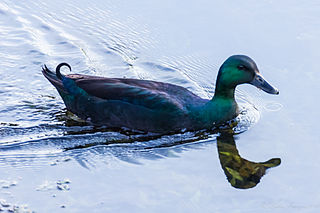
The Cayuga is an American breed of domestic duck. It was introduced to the Finger Lakes region of New York State in about 1840, and is named for the Cayuga people of that area. Until the last years of the nineteenth century it was the principal duck reared for meat in the United States. In the twenty-first century it is kept mainly for ornament. The plumage is black with iridescent beetle-green lights.
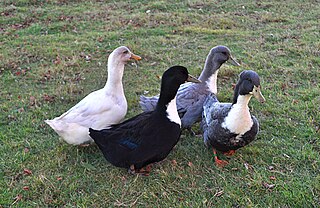
The Swedish Blue or Blue Swedish is a Swedish breed of domestic duck. It originated in the former dominion of Swedish Pomerania – now in north-west Poland and north-east Germany – and is documented there from 1835. It is closely similar to the Pomeranian Duck from the same general area, differing mainly in its white primary feathers.

The Rouen is a heavyweight breed of domesticated duck. Rouens are raised primarily for meat, exhibition, or as general purpose ducks. Since they are not prolific egg layers, Rouen ducks are most commonly bred for their meat. The breed originated in France sometime before the 19th century.
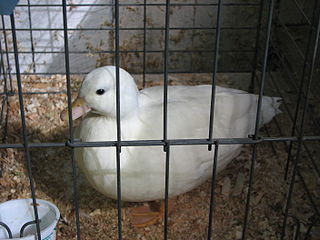
The Call is a historic breed of small domestic duck. It is believed to have originated in the Netherlands, where the earliest descriptions and depictions of it date from the seventeenth century. It is similar in appearance to some other breeds of ducks, but is much smaller, with a round head and very short bill. Female Ducks, but not drakes, are very loquacious and noisy, with a piercing high-pitched call which can be heard from far away.

The Orpington or Buff Orpington Duck is a breed of domestic duck. It is a dual-purpose breed used for meat and egg production. It is capable of laying up to 220 eggs a year. Originally created by William Cook of Orpington, Kent, England, from the selection of mis-marked Blue Orpington Ducks; Cook was also the developer of the Orpington chicken. The breeds used in the development of the breed included Cayuga, Indian Runner, commercial Aylesbury and Rouen. It is proposed that Cook's intentions for the breed were to capitalize on the growing demand for the buff colour pattern. The Buff Orpington Duck was introduced to the public at the Dairy Show, the Agricultural Hall (q.v.), Islington, London in October 1897. It is considered a threatened breed by the ALBC. This breed was admitted to the British Poultry Standard in 1910 and the American Poultry Associations Standard of Perfection as the 'Buff Duck' in the Medium class in 1914. The Orpington duck is available in three colour varieties: Buff, Blond and Brown. The Buff Orpington is an unstable colour due to a blue dilution gene which means that from the offspring, all three colour variations will appear.

The Sebastopol is a breed of domestic goose, descended from the European Greylag goose. First exhibited in England in 1860 under the name 'Sebastopol goose'; they were also referred to as Danubian geese, a name first used for the breed in Ireland in 1863. 'Danubian' was used as a synonym in the 19th century; and only given precedence by Edward Brown after the turn of the 19th century. The Sebastopol is a medium-sized goose with long, white curly feathers. The feathers of the neck are smooth and sometimes greyish brown. Crosses have produced all-grey, buff, and saddle back variants. Feathers on the breast may be curly (frizzle) or smooth. The gander weighs 12-14 lbs while the goose weighs 10-12 lbs. The legs and shanks are orange and the eyes bright blue. Grey and buff colored Sebastopol have brown eyes. On average, females produce 25-35 eggs per year. Though domesticated breeds of geese generally retain some flight ability, Sebastopols cannot fly well due to the curliness of their feathers and have difficulty getting off the ground. They need plenty of water to keep themselves clean, and to clean their sinuses.

The Magpie is a British breed of domestic duck. It has distinctive black and white markings reminiscent of the European magpie, and is a good layer of large eggs.
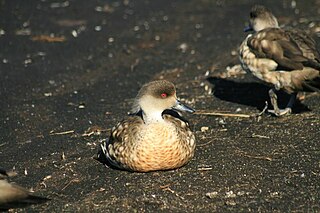
The Patagonian crested duck, also known as the southern crested duck, or the grey duck in the Falkland Islands, is the nominate of two subspecies of the crested duck.

The Silver Appleyard is a British breed of domestic duck. It was bred in the first half of the twentieth century by Reginald Appleyard, with the aim of creating a dual-purpose breed that would provide both a good quantity of meat and plenty of eggs.
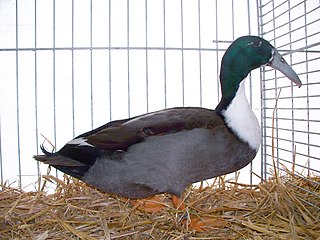
The Hook Bill or Dutch Hookbill is a breed of domestic duck characterised by an unusual down-curved beak. It is an ancient breed, and has been documented since the seventeenth century. Speculation that it originated in Asia, or is related to the Indian Runner, is apparently unsubstantiated.

The Welsh Harlequin is a breed of domestic duck originating in Wales. In 1949, in Criccieth, Group Captain Leslie Bonnet discovered a colour mutation among his flock of Khaki Campbells and began selective breeding for the trait. By 1968, hatching eggs were exported to the United States, followed by the importation of live birds in 1981.

The Saxony duck is a German breed of domestic duck. It was bred in Saxony in the 1930s, but because of the Second World War was recognised only in 1957.

The Golden Cascade is a breed of domestic duck developed in the United States. In 1979, David Holderread of Corvallis, Oregon set out to breed a duck that was fast growing, active, laid eggs well, and was auto-sexing. By the mid-1980s, the Golden Cascade was introduced to the market. It is not yet admitted to the American Poultry Association's Standard of Perfection.
The Shetland duck is a breed of domestic duck originating in the Shetland Islands of Scotland. It is critically endangered.

Altsteirer, also known as the Styrian Hen and Chicken, Slovene: Štajerska kokoš or Štajerka, German: Altsteirer Huhn, is an autochthonous breed of domestic chicken originating in Slovenia and Austrian state Styria. The Styrian Hen is known as the only autochthonous (native) chicken breed of Slovenian area, with all other breeds being traditional at most, hence introduced in the past and consequently adapted to country's conditions. The Altsteirer's set of traits suggests the breed may share a common descent with other Mediterranean chicken breeds.
References
- 1 2 Australian Poultry Standards (2nd ed.). Ballarat, Vic.: Victorian Poultry Fanciers Association Limited. 2011. pp. 259–260. ISBN 9781921488238.
- ↑ "Ducks". rarebreeds.co.nz. Rare Breeds Conservation Society of New Zealand . Retrieved 21 December 2014.
- ↑ "Duck breeds". seqwa.net. South East Queensland Waterfowl Association. Archived from the original on 22 December 2014. Retrieved 21 December 2014.
- 1 2 3 Murtagh, Nyiri (2012-01-01). The Backyard Duck Book: For the Love of Ducks. Csiro Publishing. pp. 32–33. ISBN 9780643106512.
- ↑ "Status of Rare Breeds of Domestic Farm Livestock in Australia 2004" (PDF). rbta.org. Rare Breeds Trust of Australia. Archived from the original (PDF) on 11 April 2014. Retrieved 21 December 2014.